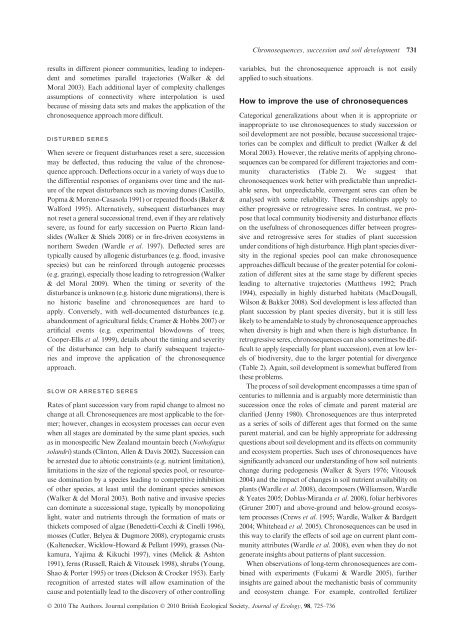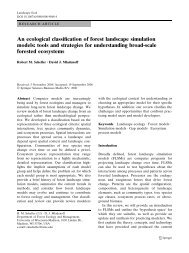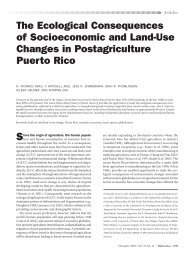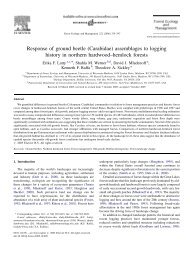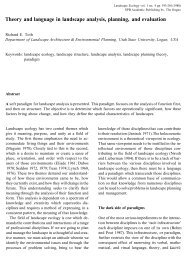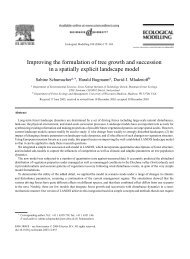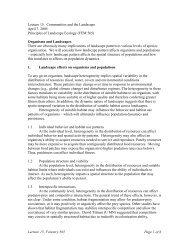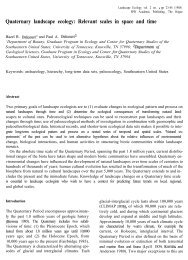The use of chronosequences in studies of ecological succession ...
The use of chronosequences in studies of ecological succession ...
The use of chronosequences in studies of ecological succession ...
You also want an ePaper? Increase the reach of your titles
YUMPU automatically turns print PDFs into web optimized ePapers that Google loves.
Chronosequences, <strong>succession</strong> and soil development 731results <strong>in</strong> different pioneer communities, lead<strong>in</strong>g to <strong>in</strong>dependentand sometimes parallel trajectories (Walker & delMoral 2003). Each additional layer <strong>of</strong> complexity challengesassumptions <strong>of</strong> connectivity where <strong>in</strong>terpolation is <strong>use</strong>dbeca<strong>use</strong> <strong>of</strong> miss<strong>in</strong>g data sets and makes the application <strong>of</strong> thechronosequence approach more difficult.DISTURBED SERESWhen severe or frequent disturbances reset a sere, <strong>succession</strong>may be deflected, thus reduc<strong>in</strong>g the value <strong>of</strong> the chronosequenceapproach. Deflections occur <strong>in</strong> a variety <strong>of</strong> ways due tothe differential responses <strong>of</strong> organisms over time and the nature<strong>of</strong> the repeat disturbances such as mov<strong>in</strong>g dunes (Castillo,Popma & Moreno-Casasola 1991) or repeated floods (Baker &Walford 1995). Alternatively, subsequentdisturbancesmaynot reset a general <strong>succession</strong>al trend, even if they are relativelysevere, as found for early <strong>succession</strong> on Puerto Rican landslides(Walker & Shiels 2008) or <strong>in</strong> fire-driven ecosystems <strong>in</strong>northern Sweden (Wardle et al. 1997). Deflected seres aretypically ca<strong>use</strong>d by allogenic disturbances (e.g. flood, <strong>in</strong>vasivespecies) but can be re<strong>in</strong>forced through autogenic processes(e.g. graz<strong>in</strong>g), especially those lead<strong>in</strong>g to retrogression (Walker& del Moral 2009). When the tim<strong>in</strong>g or severity <strong>of</strong> thedisturbance is unknown (e.g. historic dune migrations), there isno historic basel<strong>in</strong>e and <strong>chronosequences</strong> are hard toapply. Conversely, with well-documented disturbances (e.g.abandonment <strong>of</strong> agricultural fields; Cramer & Hobbs 2007) orartificial events (e.g. experimental blowdowns <strong>of</strong> trees;Cooper-Ellis et al. 1999), details about the tim<strong>in</strong>g and severity<strong>of</strong> the disturbance can help to clarify subsequent trajectoriesand improve the application <strong>of</strong> the chronosequenceapproach.SLOW OR ARRESTED SERESRates <strong>of</strong> plant <strong>succession</strong> vary from rapid change to almost nochange at all. Chronosequences are most applicable to the former;however, changes <strong>in</strong> ecosystem processes can occur evenwhen all stages are dom<strong>in</strong>ated by the same plant species, suchas <strong>in</strong> monospecific New Zealand mounta<strong>in</strong> beech (Noth<strong>of</strong>agussolandri) stands (Cl<strong>in</strong>ton, Allen & Davis 2002). Succession canbe arrested due to abiotic constra<strong>in</strong>ts (e.g. nutrient limitation),limitations <strong>in</strong> the size <strong>of</strong> the regional species pool, or resource<strong>use</strong>dom<strong>in</strong>ation by a species lead<strong>in</strong>g to competitive <strong>in</strong>hibition<strong>of</strong> other species, at least until the dom<strong>in</strong>ant species senesces(Walker & del Moral 2003). Both native and <strong>in</strong>vasive speciescan dom<strong>in</strong>ate a <strong>succession</strong>al stage, typically by monopoliz<strong>in</strong>glight, water and nutrients through the formation <strong>of</strong> mats orthickets composed <strong>of</strong> algae (Benedetti-Cecchi & C<strong>in</strong>elli 1996),mosses (Cutler, Belyea & Dugmore 2008), cryptogamic crusts(Kaltenecker, Wicklow-Howard & Pellant 1999), grasses (Nakamura,Yajima & Kikuchi 1997), v<strong>in</strong>es (Melick & Ashton1991), ferns (Russell, Raich & Vito<strong>use</strong>k 1998), shrubs (Young,Shao & Porter 1995) or trees (Dickson & Crocker 1953). Earlyrecognition <strong>of</strong> arrested states will allow exam<strong>in</strong>ation <strong>of</strong> theca<strong>use</strong> and potentially lead to the discovery <strong>of</strong> other controll<strong>in</strong>gvariables, but the chronosequence approach is not easilyapplied to such situations.How to improve the <strong>use</strong> <strong>of</strong> <strong>chronosequences</strong>Categorical generalizations about when it is appropriate or<strong>in</strong>appropriate to <strong>use</strong> <strong>chronosequences</strong> to study <strong>succession</strong> orsoil development are not possible, beca<strong>use</strong> <strong>succession</strong>al trajectoriescan be complex and difficult to predict (Walker & delMoral 2003). However, the relative merits <strong>of</strong> apply<strong>in</strong>g <strong>chronosequences</strong>can be compared for different trajectories and communitycharacteristics (Table 2). We suggest that<strong>chronosequences</strong> work better with predictable than unpredictableseres, but unpredictable, convergent seres can <strong>of</strong>ten beanalysed with some reliability. <strong>The</strong>se relationships apply toeither progressive or retrogressive seres. In contrast, we proposethat local community biodiversity and disturbance effectson the <strong>use</strong>fulness <strong>of</strong> <strong>chronosequences</strong> differ between progressiveand retrogressive seres for <strong>studies</strong> <strong>of</strong> plant <strong>succession</strong>under conditions <strong>of</strong> high disturbance. High plant species diversity<strong>in</strong> the regional species pool can make chronosequenceapproaches difficult beca<strong>use</strong> <strong>of</strong> the greater potential for colonization<strong>of</strong> different sites at the same stage by different specieslead<strong>in</strong>g to alternative trajectories (Matthews 1992; Prach1994), especially <strong>in</strong> highly disturbed habitats (MacDougall,Wilson & Bakker 2008). Soil development is less affected thanplant <strong>succession</strong> by plant species diversity, but it is still lesslikely to be amendable to study by chronosequence approacheswhen diversity is high and when there is high disturbance. Inretrogressive seres, <strong>chronosequences</strong> can also sometimes be difficultto apply (especially for plant <strong>succession</strong>), even at low levels<strong>of</strong> biodiversity, due to the larger potential for divergence(Table2).Aga<strong>in</strong>,soildevelopmentissomewhatbufferedfromthese problems.<strong>The</strong> process <strong>of</strong> soil development encompasses a time span <strong>of</strong>centuries to millennia and is arguably more determ<strong>in</strong>istic than<strong>succession</strong> once the roles <strong>of</strong> climate and parent material areclarified (Jenny 1980). Chronosequences are thus <strong>in</strong>terpretedas a series <strong>of</strong> soils <strong>of</strong> different ages that formed on the sameparent material, and can be highly appropriate for address<strong>in</strong>gquestions about soil development and its effects on communityand ecosystem properties. Such <strong>use</strong>s <strong>of</strong> <strong>chronosequences</strong> havesignificantly advanced our understand<strong>in</strong>g <strong>of</strong> how soil nutrientschange dur<strong>in</strong>g pedogenesis (Walker & Syers 1976; Vito<strong>use</strong>k2004) and the impact <strong>of</strong> changes <strong>in</strong> soil nutrient availability onplants (Wardle et al. 2008), decomposers (Williamson, Wardle& Yeates 2005; Doblas-Miranda et al. 2008), foliar herbivores(Gruner 2007) and above-ground and below-ground ecosystemprocesses (Crews et al. 1995; Wardle, Walker & Bardgett2004; Whitehead et al. 2005). Chronosequences can be <strong>use</strong>d <strong>in</strong>this way to clarify the effects <strong>of</strong> soil age on current plant communityattributes (Wardle et al. 2008), even when they do notgenerate <strong>in</strong>sights about patterns <strong>of</strong> plant <strong>succession</strong>.When observations <strong>of</strong> long-term <strong>chronosequences</strong> are comb<strong>in</strong>edwith experiments (Fukami & Wardle 2005), further<strong>in</strong>sights are ga<strong>in</strong>ed about the mechanistic basis <strong>of</strong> communityand ecosystem change. For example, controlled fertilizerÓ 2010 <strong>The</strong> Authors. Journal compilation Ó 2010 British Ecological Society, Journal <strong>of</strong> Ecology, 98, 725–736


